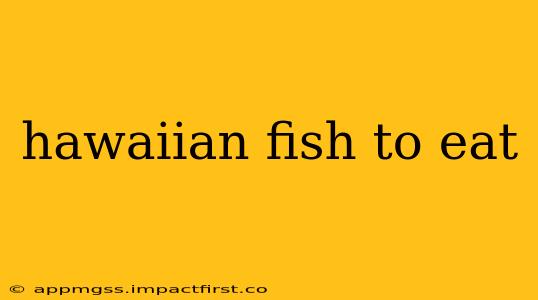Hawaii's vibrant marine ecosystem boasts a stunning array of fish, many of which are delicious and sustainable choices. However, understanding which fish to eat and which to avoid is crucial for protecting this precious resource. This guide explores popular Hawaiian fish, highlighting their taste, sustainability, and responsible consumption practices.
What are the best-tasting Hawaiian fish?
Taste is subjective, but some Hawaiian fish consistently receive high praise for their flavor. These include:
-
Ono (Wahoo): Known for its firm, white flesh and mild, slightly sweet flavor, Ono is a popular choice for grilling, pan-searing, or making poke. Its rich taste profile makes it a favorite among locals and tourists alike.
-
Mahi-Mahi (Dolphin Fish): This flaky, white fish offers a delicate, buttery flavor. It's versatile, suitable for various cooking methods, and often prepared as steaks or fillets.
-
Ahi (Yellowfin Tuna): A prized catch, Ahi boasts a rich, deep red color and a robust, slightly sweet taste. Its firm texture makes it perfect for sashimi, poke, or grilling.
-
Monchong: This white, flaky fish is known for its mild, slightly sweet flavor and firm texture. It's a versatile option suitable for many cooking methods.
What are some sustainable Hawaiian fish to eat?
Sustainability is paramount when choosing Hawaiian fish. Opting for species managed responsibly ensures the health of the ocean's ecosystem for future generations. While specific regulations change, generally, sustainably managed fish include:
-
Monchong: Often farmed or caught using sustainable methods, Monchong represents a responsible choice.
-
Mahi-Mahi: While its population can fluctuate, responsible fishing practices can help maintain healthy Mahi-Mahi populations. Always check with local advisories for the most up-to-date information.
-
Some types of Tuna: Yellowfin tuna, when caught using sustainable methods, can be a responsible choice. However, it's crucial to check the source and fishing practices employed.
-
Locally sourced fish: Purchasing fish from local markets and fishermen ensures that you're supporting sustainable practices within your community.
Are there any Hawaiian fish I should avoid?
Some Hawaiian fish are overfished or threatened, making their consumption unsustainable. It's crucial to be informed and choose responsibly. Examples include:
- Certain reef fish: Many smaller reef fish, crucial for maintaining the balance of the coral reef ecosystem, should be avoided. Specific regulations vary; check local advisories for updated information.
What are the best ways to cook Hawaiian fish?
Hawaiian fish lend themselves to various cooking methods, each highlighting their unique flavors and textures.
-
Grilling: Ideal for firm, flavorful fish like Ono and Ahi, grilling brings out their natural taste.
-
Pan-searing: A quick and easy method, pan-searing creates a crispy exterior while keeping the interior moist. Mahi-Mahi and Monchong are excellent choices.
-
Poke: A traditional Hawaiian dish, poke uses raw fish marinated in soy sauce, sesame oil, and other seasonings. Ahi and Ono are frequently used.
-
Steaming: A healthy option, steaming preserves the fish's delicate flavor and moisture.
Where can I buy sustainable Hawaiian fish?
The best place to buy sustainable Hawaiian fish is from local fish markets or directly from fishermen who employ responsible practices. Ask about their sourcing and fishing methods to ensure you're making an informed and environmentally conscious choice. Farmers' markets often feature locally sourced seafood with information about sustainable practices.
What are the environmental impacts of eating Hawaiian fish?
Overfishing and destructive fishing practices threaten the delicate balance of Hawaii's marine ecosystem. Choosing sustainable seafood helps to protect coral reefs, support biodiversity, and ensure the long-term health of the ocean. Understanding the source of your fish and opting for responsibly caught options is crucial for minimizing environmental impact.
How can I tell if the fish I'm buying is sustainable?
Look for certifications from reputable organizations like the Marine Stewardship Council (MSC). These certifications indicate that the fish was caught or farmed using environmentally sustainable practices. Also, inquire directly with the seller about their sourcing and fishing methods.
This guide provides a starting point for making informed choices about the Hawaiian fish you consume. Remember to always consult local advisories and resources for the most up-to-date information on sustainable fishing practices and species to avoid. By choosing wisely, you can enjoy the delicious flavors of Hawaiian fish while helping to preserve this precious marine ecosystem.
